The Cambridge History of China. Vol. 06. Alien Regimes and Border States, 907-1368
Подождите немного. Документ загружается.


BIBLIOGRAPHICAL ESSAYS 693
biographies in the biographical chapters of the work, a serious anomaly by Chinese
historiographical standards.
The biographies
(lieh-chuan)
in ninety-seven
chiian
are the most frequently criti-
cized portion of the Yuan shih. In no fewer than nine cases, for example, one
individual (all non-Han persons) appears as the subject of
two
biographies, although
his name is written differently, as if two different persons were being recorded. In
many cases the name of
one
person is written differently in different chapters. Many
other faults in the biographies have been pointed out, especially during the Ch'ing
dynasty when several important attempts were made to supplement or supersede the
Yuan
shih.
Of particular concern then was the inadequacy of all kinds of information
on the pre-1260 portions of Mongolian history. That concern remains; in this century
it has until recently been addressed primarily
by
Japanese and Western historians. A
high point of interest in the Yuan period by Chinese scholars was reached in the late
eighteenth and nineteenth centuries,'
8
but probably no Han Chinese historians
during all of Ming and Ch'ing times ever acquired a sound working knowledge of
Mongolian. Their emphasis was mainly on China in the period of alien rule, not on
the Mongols themselves.
The
Secret history
The Mongols' most important record of their own early history is the so-called
Secret
history
of
the
Mongols,
usually called in Chinese
Yuan
ch'ao pi
shih
(Secret history of the
Yuan dynasty). Its name in Mongolian as reconstructed from the Chinese-character
transliteration is
Mongghol-un ni'ucha
tobchiyan,
which is more correctly translated
into Chinese as
Meng-ku
pi
shih,
with the same meaning as the English title. Both
Chinese names are now used. The existing translation into Chinese accompanied by a
transliteration using Chinese characters as (highly imperfect) phonetic symbols is the
only surviving written version and has been the basis for all modern reconstructions
of the original Mongolian text and for its translations into modern Chinese, Japanese,
and Western languages.
I9
Scholars do not agree on the date when the
Secret history
was composed, the date
when it was first written down in Mongolian (using Uighur script), the date when it
was first translated into Chinese, or the date when it was first published. The
18 See Cheng Ho-sheng, "Ch'ing ju tui yii Yuan shih hsiieh chih yen chiu," Shih ti hsiiehpao, 3, no. 4
(December 1924), pp. 1-23; and 3, no. 5 (March 1925), pp. 1-22. Also Tu Wei-yiin, Ch'ing taishih
hsiieh
yii shih chia (Taipei, 1984).
19 See the introduction of Francis Woodman Cleaves, The
secret
history of the
Mongols,
for
the
first time
done
into English out of
the
original
tongue
and provided with an
exegetical
commentary,
pt. I (translation) (set in
type, 1957; Cambridge, Mass., 1982), pp. xvii—lxv. For references to other scholarship on the
Secret
history, see Thomas T. Allsen, The Mongols in East Asia,
twelfth—fourteenth
centuries:
A preliminary
bibliography of
books
and
articles
in
Western
languages.
Sung Studies Newsletter (Philadelphia, 1976), esp.
pp.
7—10; and Sechin Jagchid (Cha-ch'i Ssu-ch'in), Meng-ku pi shih hsin i ping chu shih (A new
translation of the
Secret
history of
the Mongols
with commentary), with an introduction by Yao Ts'ung-wu
(Taipei, 1979). The latest translation of the
Secret
history into English is that by Igor de Rachewiltz,
published serially in
Papers
on Far
Eastern
History, nos. 4, 5, 10, 13, 16, 18, 21, 23, 26, 30, and 31
(Canberra, 1971—85).
Cambridge Histories Online © Cambridge University Press, 2008
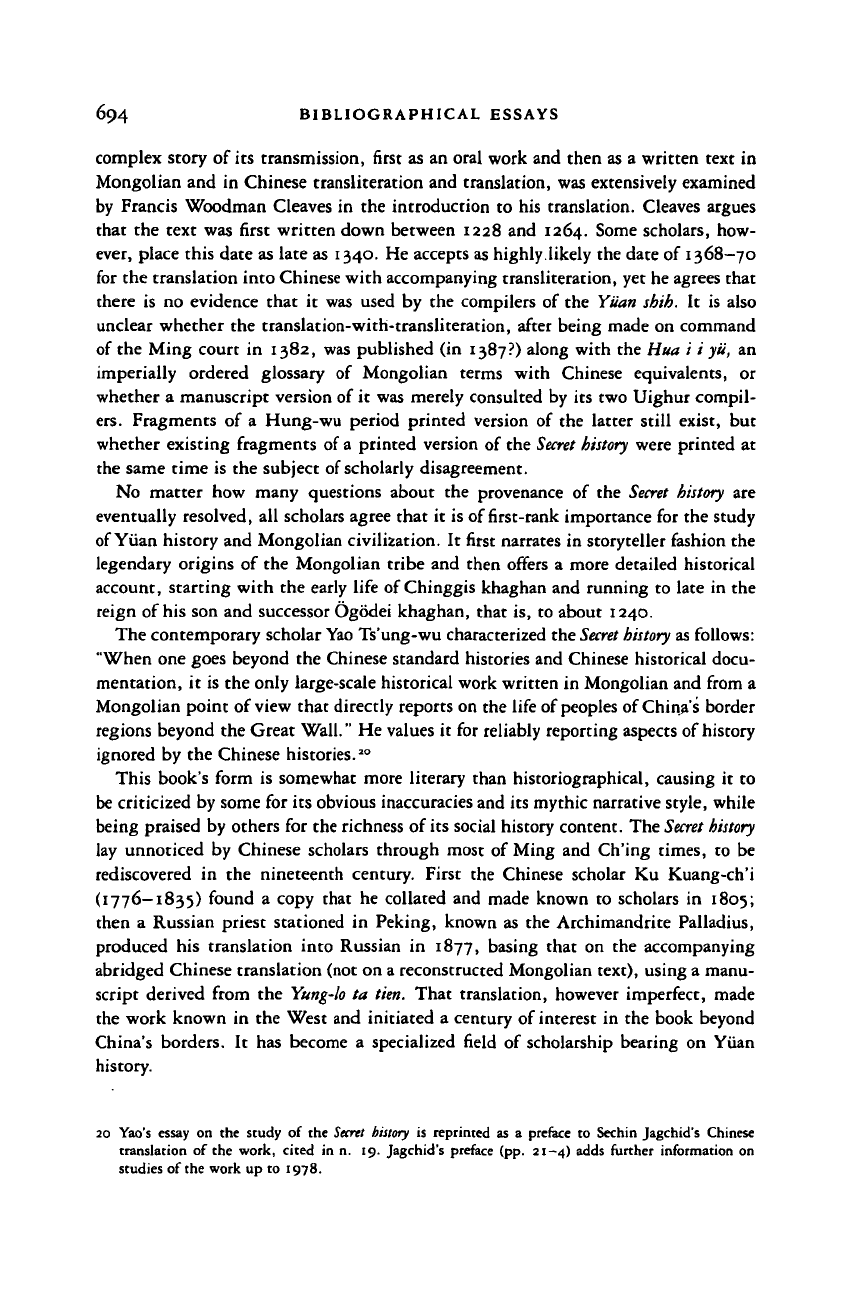
694 BIBLIOGRAPHICAL ESSAYS
complex story of its transmission, first as an oral work and then as a written text in
Mongolian and in Chinese transliteration and translation, was extensively examined
by Francis Woodman Cleaves in the introduction to his translation. Cleaves argues
that the text was first written down between 1228 and 1264. Some scholars, how-
ever, place this date as late as 1340. He accepts as highly.likely the date of 1368-70
for the translation into Chinese with accompanying transliteration, yet he agrees that
there is no evidence that it was used by the compilers of the Yuan shih. It is also
unclear whether the translation-with-transliteration, after being made on command
of the Ming court in 1382, was published (in 1387?) along with the Hua i i
yii,
an
imperially ordered glossary of Mongolian terms with Chinese equivalents, or
whether a manuscript version of it was merely consulted by its two Uighur compil-
ers.
Fragments of a Hung-wu period printed version of the latter still exist, but
whether existing fragments of
a
printed version of the
Secret history
were printed at
the same time is the subject of scholarly disagreement.
No matter how many questions about the provenance of the
Secret history
are
eventually resolved, all scholars agree that it is of first-rank importance for the study
of Yuan history and Mongolian civilization. It first narrates in storyteller fashion the
legendary origins of the Mongolian tribe and then offers a more detailed historical
account, starting with the early life of Chinggis khaghan and running to late in the
reign of his son and successor Ogodei khaghan, that is, to about 1240.
The contemporary scholar
Yao
Ts'ung-wu characterized the
Secret history
as follows:
"When one goes beyond the Chinese standard histories and Chinese historical docu-
mentation, it is the only large-scale historical work written in Mongolian and from a
Mongolian point of view that directly reports on the life of
peoples
of China's border
regions beyond the Great Wall." He values it for reliably reporting aspects of history
ignored by the Chinese histories.
20
This book's form is somewhat more literary than historiographical, causing it to
be criticized by some for its obvious inaccuracies and its mythic narrative style, while
being praised by others for the richness of its social history content. The
Secret history
lay unnoticed by Chinese scholars through most of Ming and Ch'ing times, to be
rediscovered in the nineteenth century. First the Chinese scholar Ku Kuang-ch'i
(1776—1835) found a copy that he collated and made known to scholars in 1805;
then a Russian priest stationed in Peking, known as the Archimandrite Palladius,
produced his translation into Russian in 1877, basing that on the accompanying
abridged Chinese translation (not on a reconstructed Mongolian text), using a manu-
script derived from the
Yung-lo
ta
tien.
That translation, however imperfect, made
the work known in the West and initiated a century of interest in the book beyond
China's borders. It has become a specialized field of scholarship bearing on Yuan
history.
20 Yao's essay on the study of the
Secret
history is reprinted as a preface to Sechin Jagchid's Chinese
translation of the work, cited in n. 19. Jagchid's preface (pp. 21-4) adds further information on
studies of the work up to 1978.
Cambridge Histories Online © Cambridge University Press, 2008
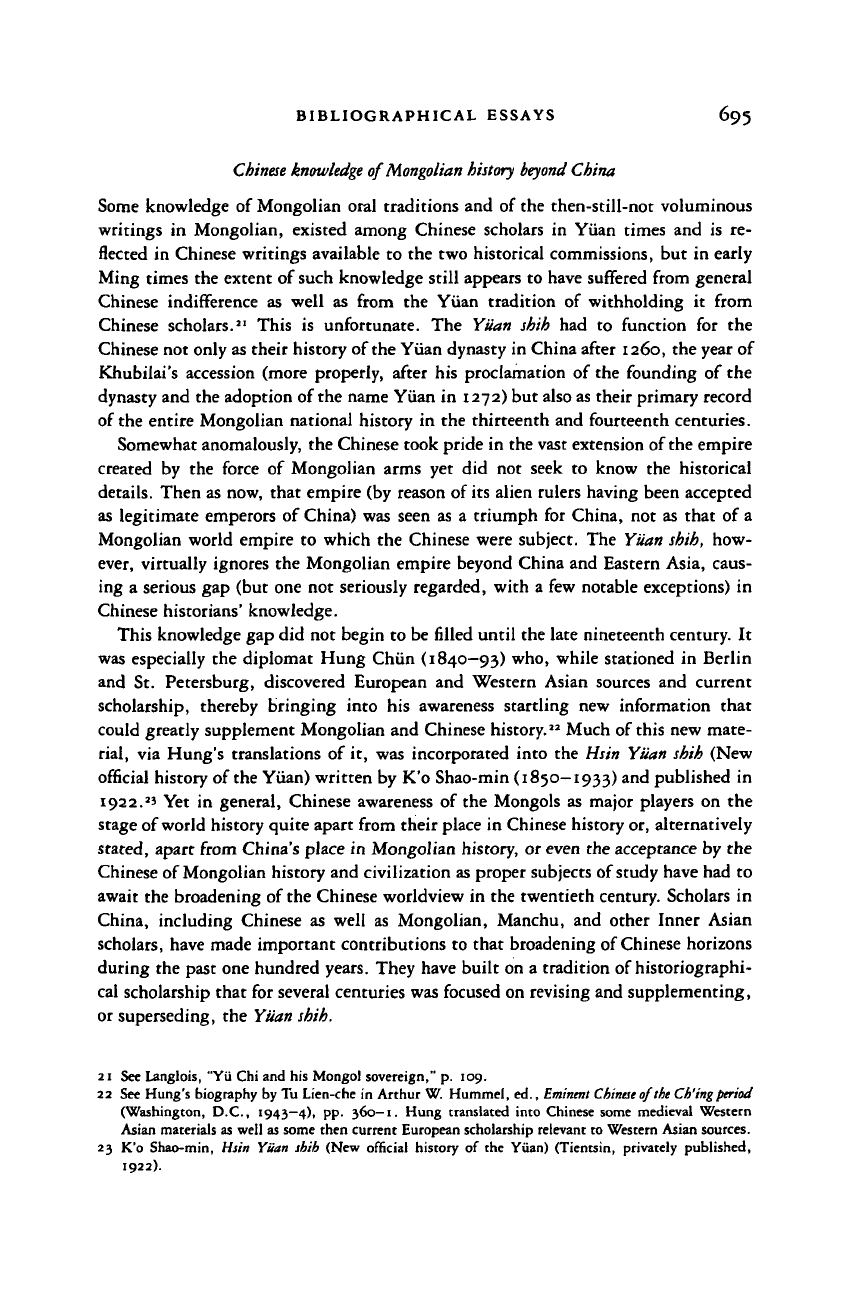
BIBLIOGRAPHICAL ESSAYS 695
Chinese knowledge
of Mongolian
history beyond
China
Some knowledge of Mongolian oral traditions and of the then-still-not voluminous
writings in Mongolian, existed among Chinese scholars in Yuan times and is re-
flected in Chinese writings available to the two historical commissions, but in early
Ming times the extent of such knowledge still appears to have suffered from general
Chinese indifference as well as from the Yuan tradition of withholding it from
Chinese scholars.
21
This is unfortunate. The Yuan shih had to function for the
Chinese not only as their history of
the
Yuan dynasty in China after 1260, the year of
Khubilai's accession (more properly, after his proclamation of the founding of the
dynasty and the adoption of the name Yuan in 1272) but also as their primary record
of the entire Mongolian national history in the thirteenth and fourteenth centuries.
Somewhat anomalously, the Chinese took pride in the vast extension of
the
empire
created by the force of Mongolian arms yet did not seek to know the historical
details. Then as now, that empire (by reason of its alien rulers having been accepted
as legitimate emperors of China) was seen as a triumph for China, not as that of a
Mongolian world empire to which the Chinese were subject. The Yuan
shih,
how-
ever, virtually ignores the Mongolian empire beyond China and Eastern Asia, caus-
ing a serious gap (but one not seriously regarded, with a few notable exceptions) in
Chinese historians' knowledge.
This knowledge gap did not begin to be filled until the late nineteenth century. It
was especially the diplomat Hung Chun (1840-93) who, while stationed in Berlin
and St. Petersburg, discovered European and Western Asian sources and current
scholarship, thereby bringing into his awareness startling new information that
could greatly supplement Mongolian and Chinese history.
22
Much of this new mate-
rial,
via Hung's translations of it, was incorporated into the Hsin Yuan shih (New
official history of the Yuan) written by K'o Shao-min (1850-1933) and published in
1922.
2
'
Yet in general, Chinese awareness of the Mongols as major players on the
stage of world history quite apart from their place in Chinese history or, alternatively
stated, apart from China's place in Mongolian history, or even the acceptance by the
Chinese of Mongolian history and civilization as proper subjects of study have had to
await the broadening of the Chinese worldview in the twentieth century. Scholars in
China, including Chinese as well as Mongolian, Manchu, and other Inner Asian
scholars, have made important contributions to that broadening of
Chinese
horizons
during the past one hundred years. They have built on a tradition of historiographi-
cal scholarship that for several centuries was focused on revising and supplementing,
or superseding, the
Yiian
shih.
21 See Langlois, "Yii Chi and his Mongol sovereign," p. 109.
22 See Hung's biography by Tu Lien-che in Arthur W. Hummel, ed.,
Eminent Chinese
of the Ch'ing period
(Washington, D.C., 1943—4), pp.
360-1.
Hung translated into Chinese some medieval Western
Asian materials as well as some then current European scholarship relevant to Western Asian sources.
23 K'o Shao-min, Hsin Yuan shih (New official history of the Yiian) (Tientsin, privately published,
1922).
Cambridge Histories Online © Cambridge University Press, 2008
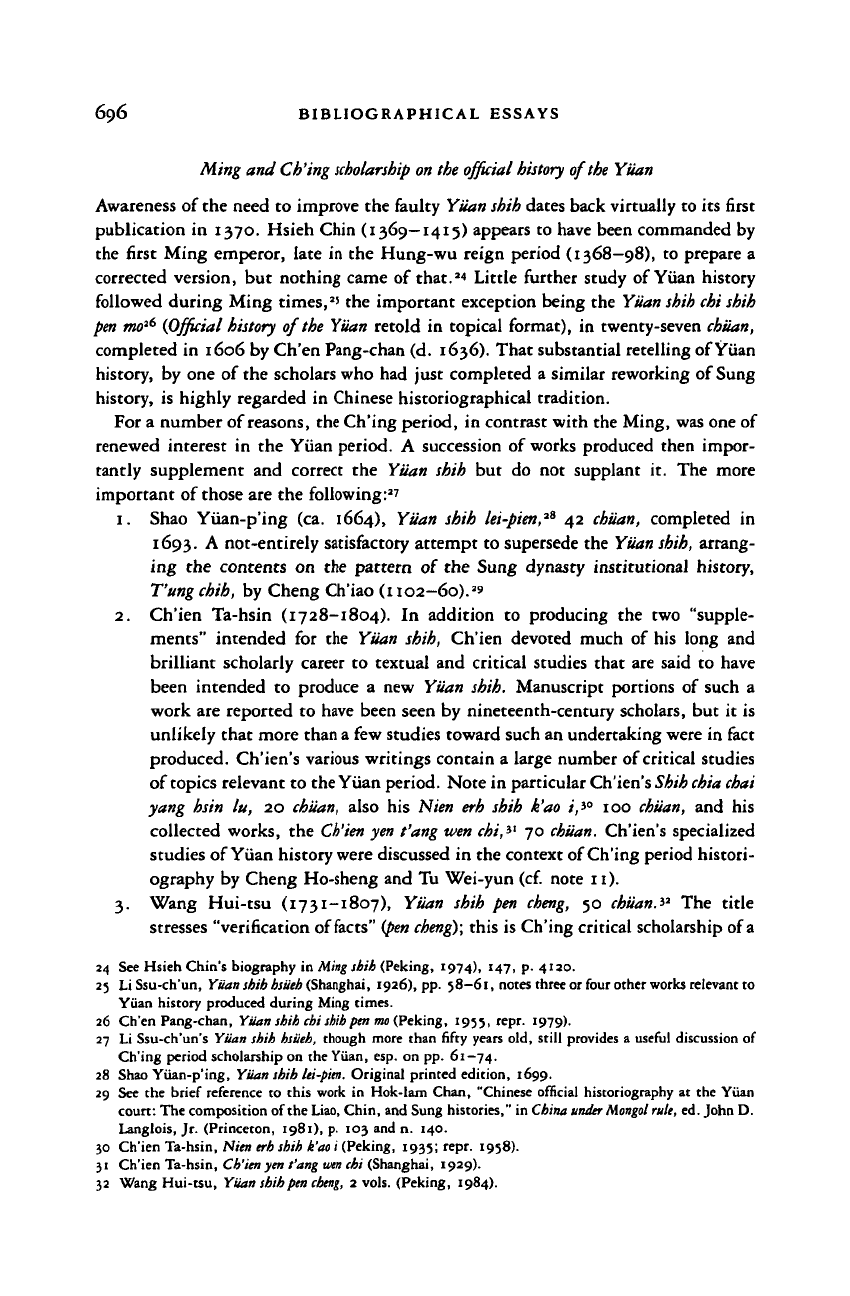
696 BIBLIOGRAPHICAL ESSAYS
Ming and Ch'ing
scholarship
on the
official history
of the Yuan
Awareness of the need to improve the faulty Yuan
shih
dates back virtually to its first
publication in 1370. Hsieh Chin (1369—1415) appears to have been commanded by
the first Ming emperor, late in the Hung-wu reign period (1368—98), to prepare a
corrected version, but nothing came of that.
2
* Little further study of Yuan history
followed during Ming times,
2
' the important exception being the
Yuan shih chi shih
pen mo'
6
{.Official
history of the Yuan retold in topical format), in twenty-seven chiian,
completed in 1606 by Ch'en Pang-chan (d. 1636). That substantial retelling of Yuan
history, by one of the scholars who had just completed a similar reworking of Sung
history, is highly regarded in Chinese historiographical tradition.
For a number of
reasons,
the Ch'ing period, in contrast with the Ming, was one of
renewed interest in the Yiian period. A succession of works produced then impor-
tantly supplement and correct the Yuan shih but do not supplant it. The more
important of those are the following:
27
1.
Shao Yiian-p'ing (ca. 1664), Yiian shih
lei-pien,
28
42
chiian,
completed in
1693.
A not-entirely satisfactory attempt to supersede the
Yiian
shih,
arrang-
ing the contents on the pattern of the Sung dynasty institutional history,
Tung
chih,
by Cheng Ch'iao (1102—60).
29
2.
Ch'ien Ta-hsin (1728-1804). In addition to producing the two "supple-
ments" intended for the Yiian shih, Ch'ien devoted much of his long and
brilliant scholarly career to textual and critical studies that are said to have
been intended to produce a new Yiian shih. Manuscript portions of such a
work are reported to have been seen by nineteenth-century scholars, but it is
unlikely that more than
a
few studies toward such an undertaking were in fact
produced. Ch'ien's various writings contain a large number of
critical
studies
of topics relevant to the Yiian period. Note in particular Ch'ien's
Shih chia chai
yang hsin lu, 20
chiian,
also his Nien erh shih k'ao i,*° 100
chiian,
and his
collected works, the
Ch'ien yen
t'ang
wen
chi,
il
70
chiian.
Ch'ien's specialized
studies of Yiian history were discussed in the context of Ch'ing period histori-
ography by Cheng Ho-sheng and Tu Wei-yun (cf. note 11).
3.
Wang Hui-tsu (1731-1807), Yiian shih pen
cheng,
50
chiian.*
2
The title
stresses "verification of
facts"
(pen
cheng);
this is Ch'ing critical scholarship of a
24 See Hsieh Chin's biography in Ming sbih (Peking, 1974), 147, p. 4120.
25 Li Ssu-ch'un, Yiian shih
bsiieb
(Shanghai, 1926), pp.
58-61,
notes three or four other works relevant to
Yiian history produced during Ming times.
26 Ch'en Pang-chan, Yiian shih chi
shib
pen
mo
(Peking, 1955, repr. 1979).
27 Li Ssu-ch'un's Yuan shih bsiieb, though more than fifty years old, still provides a useful discussion of
Ch'ing period scholarship on the Yiian, esp. on pp. 61-74.
28 Shao Yiian-p'ing, Yuan sbih lei-pim. Original printed edition, 1699.
29 See the brief reference to this work in Hok-lam Chan, "Chinese official historiography at the Yiian
court: The composition of the Liao, Chin, and Sung histories," in China
under Mongol
rule,
ed. John D.
Langlois, Jr. (Princeton, 1981), p. 103 and n. 140.
30 Ch'ien Ta-hsin, Him erh shih k'ao i (Peking, 1935; repr. 1958).
31 Ch'ien Ta-hsin, Ch'ien yen t'ang
wen
chi (Shanghai, 1929).
32 Wang Hui-tsu, Yuan shih
pen
cbeng,
2 vols. (Peking, 1984).
Cambridge Histories Online © Cambridge University Press, 2008
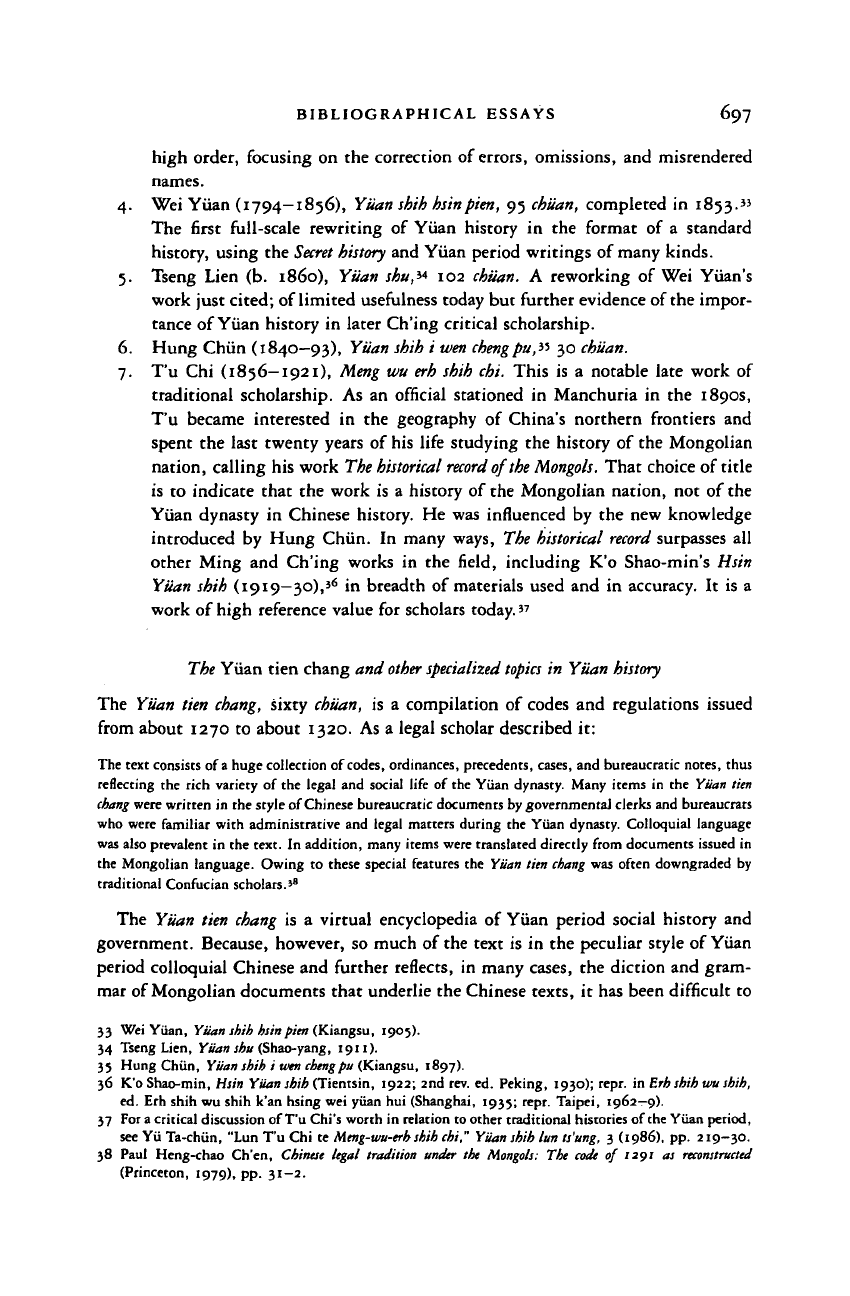
BIBLIOGRAPHICAL ESSAYS 697
high order, focusing on the correction of errors, omissions, and misrendered
names.
4.
Wei Yuan (1794-1856), Yiian sbih hsinpien, 95 cbiian, completed in 1853.5'
The first full-scale rewriting of Yiian history in the format of a standard
history, using the
Secret
history and Yiian period writings of many kinds.
5.
Tseng Lien (b. i860), Yiian shu,* 102 chiian. A reworking of Wei Yiian's
work just cited; of limited usefulness today but further evidence of the impor-
tance of Yiian history in later Ch'ing critical scholarship.
6. Hung Chun (1840—93), Yiian shih i wen chengpu," 30 cbiian.
7.
T'u Chi (1856—1921), Meng wu erh shih chi. This is a notable late work of
traditional scholarship. As an official stationed in Manchuria in the 1890s,
T'u became interested in the geography of China's northern frontiers and
spent the last twenty years of his life studying the history of the Mongolian
nation, calling his work The
historical record
of the
Mongols.
That choice of title
is to indicate that the work is a history of the Mongolian nation, not of the
Yiian dynasty in Chinese history. He was influenced by the new knowledge
introduced by Hung Chiin. In many ways, The historical
record
surpasses all
other Ming and Ch'ing works in the field, including K'o Shao-min's Hsin
Yiian shih (1919—30),
36
in breadth of materials used and in accuracy. It is a
work of high reference value for scholars today.
37
The Yiian tien chang and
other specialized topics
in Yiian history
The Yiian tien chang, sixty chiian, is a compilation of codes and regulations issued
from about 1270 to about 1320. As a legal scholar described it:
The text consists of
a
huge collection of codes, ordinances, precedents, cases, and bureaucratic notes, thus
reflecting the rich variety of the legal and social life of the Yuan dynasty. Many items in the Yiian tien
chang
were written in the style of Chinese bureaucratic documents by governmental clerks and bureaucrats
who were familiar with administrative and legal matters during the Yiian dynasty. Colloquial language
was also prevalent in the text. In addition, many items were translated directly from documents issued in
the Mongolian language. Owing to these special features the Yiian lien
chang
was often downgraded by
traditional Confucian scholars.'
8
The Yiian tien chang is a virtual encyclopedia of Yiian period social history and
government. Because, however, so much of the text is in the peculiar style of Yiian
period colloquial Chinese and further reflects, in many cases, the diction and gram-
mar of Mongolian documents that underlie the Chinese texts, it has been difficult to
33 Wei Yiian, Yiian shih
hsin
pien (Kiangsu, 1905).
34 Tseng Lien, Yiian shu (Shao-yang, 1911).
35 Hung Chiin, Yiian shih i wen chengpit (Kiangsu, 1897).
36 K'o Shao-min, Hsin Yiian shih (Tientsin, 1922; 2nd rev. ed. Peking, 1930); repr. in Erhshih wu shih,
ed.
Erh shih wu shih k'an rising wei yiian hui (Shanghai, 1935; repr. Taipei, 1962—9).
37 For a critical discussion of T'u Chi's worth in relation to other traditional histories of the Yiian period,
see Yii Ta-chiin, "Lun T'u Chi te
Meng-wu-erh
shih chi," Yiian shih tun ts'ung, 3 (1986), pp. 219—30.
38 Paul Heng-chao Ch'en, Chinese legal tradition under the Mongols: The code of 1291 as
reconstructed
(Princeton, 1979), pp. 31—2.
Cambridge Histories Online © Cambridge University Press, 2008

698 BIBLIOGRAPHICAL ESSAYS
read and also is offensive to cultivated Chinese because of the crudeness of its lan-
guage. Since its publication in 1908 by the noted legal scholar Shen Chia-pen, the
Yuan tien chang
has drawn the attention of scholars in China
and
Japan and has become
an important special field of Yuan history studies, involving historical linguists, legal
scholars, institutional historians, and many others. The Shen Chia-pen edition, based
on faulty manuscripts circulated over several centuries, was standard for all scholars
working on the text until 1972 when the Palace Museum (Taipei) published a
facsimile of the 1320 edition that is far superior.'» Japanese scholarship on the text
and related historical problems has been particularly noteworthy. *°
The special problems of the style of colloquial Chinese used in official contexts in
Yuan times extend beyond the Yuan
tien chang
to other kinds of
materials.
Research
on the texts of stele inscriptions, the so-called
pat hua
pei,
has become a special field
of study in recent times, as has that of the language of Yuan drama. These are, of
course, interrelated problems, both as linguistic and as social study (see Chapter 9).
All three subjects (Yuan tien
chang,
pai
hua
pet,
and Yuan drama) have drawn the
attention of scholars only in the twentieth century and have quickly developed as
scholarly undertakings, in which researchers from many countries have made signifi-
cant contributions to a common fund of knowledge.
In general, twentieth-century scholarship on the Yuan period has become an
international effort, perhaps more so than that on any other period of pre-modern
Chinese history. In no small measure, this is because the Mongolian empire of the
thirteenth and fourteenth centuries directly impinged on the national histories of
western Asian and eastern European states. But it also reflects the strategic signifi-
cance of Mongolian studies for Japan, Russia, Great Britain, and other powers in the
nineteenth and twentieth centuries. Sinological traditions bearing on Yuan history
have remained strong in China, and at the same time new scholarly approaches have
been introduced from outside. For an example of the latter, in the years between the
two world wars a number of Chinese scholars went to Japan and Europe to study
Mongolian and other Altaic and Western Asian languages; they returned to China to
initiate such scudies in the Chinese universities and research institutions. They also
were responsible for introducing and stimulating extensive translations of modern
Japanese and Western scholarship. Because of continuing interactions between Chi-
nese and Mongolian scholars, on the one hand, and centers of scholarship abroad, on
39 Yuan tien
chang,
published under the full title: Ta Yuan
sheng cheng kuo ch'ao
tien
chang
(Taipei: National
Palace Museum, 1972), 60 chiian, in 16 ts'e. Appended to the final volume is an important biblio-
graphic essay by Ch'ang Pi-te of the museum
staff.
40 Representative examples are the products of the Yuan
tien chang
Research Group (Gen
tensho
ienkyuhan)
of Kyoto University in the 1940s and 1950s, which produced Gin
tensho
sakuin ko, a topical index to
the Yiian tien
chang
in 19)7 (repr. Taipei, 1973), and a special issue of
Toho gakuho
(Kyoto), 24(1934),
devoted to issues in Yuan tien chang research. More recent is the chronological index to the work
compiled by Uematsu Tadashi, Gen
tensho
nendai sakuin (Tokyo, 1980). A careful editing of chapters
39 through 37, those relevant to the Ministry of Justice
—
that is, the chapters defining offenses and
their punishments - was published under the title
(Kotei bon)
Gen
tensho keibu
by Iwamura Shinobu and
Tanaka Kenji, 2 vols. (Kyoto, 1964, 1972). For a fuller review of relevant Japanese scholarship, see
Uematsu Tadashi, "Institutions of
the
Yuan Dynasty and Yuan Society," Gat Library Journal, 5 (Spring,
1992).
Cambridge Histories Online © Cambridge University Press, 2008
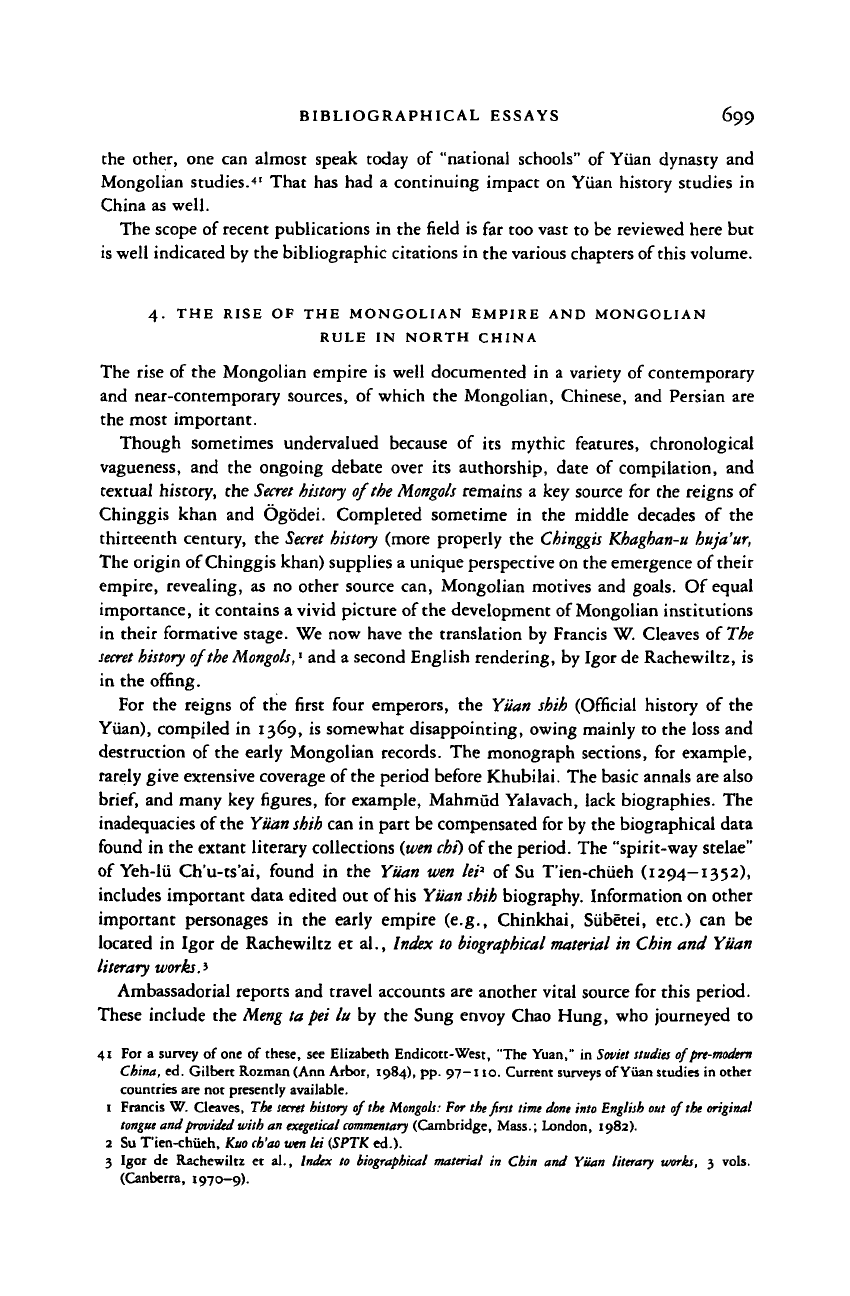
BIBLIOGRAPHICAL ESSAYS 699
the other, one can almost speak today of "national schools" of Yiian dynasty and
Mongolian studies.
4
' That has had a continuing impact on Yiian history studies in
China as well.
The scope of recent publications in the field is far too vast to be reviewed here but
is well indicated by the bibliographic citations in the various chapters of this volume.
4.
THE RISE OF THE MONGOLIAN EMPIRE AND MONGOLIAN
RULE IN NORTH CHINA
The rise of the Mongolian empire is well documented in a variety of contemporary
and near-contemporary sources, of which the Mongolian, Chinese, and Persian are
the most important.
Though sometimes undervalued because of its mythic features, chronological
vagueness, and the ongoing debate over its authorship, date of compilation, and
textual history, the
Secret
history of the
Mongols
remains a key source for the reigns of
Chinggis khan and Ogodei. Completed sometime in the middle decades of the
thirteenth century, the
Secret
history (more properly the Chinggis Khaghan-u huja'ur,
The origin of Chinggis khan) supplies a unique perspective on the emergence of their
empire, revealing, as no other source can, Mongolian motives and goals. Of equal
importance, it contains a vivid picture of the development of Mongolian institutions
in their formative stage. We now have the translation by Francis W. Cleaves of The
secret history
of the Mongols,' and a second English rendering, by Igor de Rachewiltz, is
in the offing.
For the reigns of the first four emperors, the Yiian shih (Official history of the
Yiian),
compiled in 1369, is somewhat disappointing, owing mainly to the loss and
destruction of the early Mongolian records. The monograph sections, for example,
rarely give extensive coverage of the period before Khubilai. The basic annals are also
brief,
and many key figures, for example, Mahmud Yalavach, lack biographies. The
inadequacies of the Yiian shih can in part be compensated for by the biographical data
found in the extant literary collections
(wen
chi) of the period. The "spirit-way stelae"
of Yeh-lii Ch'u-ts'ai, found in the Yiian wen lei' of Su T'ien-chiieh (1294—1352),
includes important data edited out of his Yiian shih biography. Information on other
important personages in the early empire (e.g., Chinkhai, Siibetei, etc.) can be
located in Igor de Rachewiltz et al., Index to
biographical
material in Chin and Yiian
literary
works.*
Ambassadorial reports and travel accounts are another vital source for this period.
These include the Meng ta pei lu by the Sung envoy Chao Hung, who journeyed to
41 For a survey of one of these, see Elizabeth Endicott-West, "The Yuan," in
Soviet studies
of pre-modern
China, ed. Gilbert Rozman (Ann Arbor, 1984), pp. 97-110. Current surveys of Yiian studies in other
countries are not presently available.
1 Francis W. Cleaves, The
secret
history of
the
Mongols:
For the first time
done
into English out of
the
original
tongue
and provided with an
exegetical commentary
(Cambridge, Mass.; London, 1982).
2 Su T'ien-chiieh, Kuo
cb'ao
wen lei (SPTK ed.).
3 Igor de Rachewiltz et al., Index to biographical material in Chin and Yiian literary works, 3 vols.
(Canberra, 1970—9).
Cambridge Histories Online © Cambridge University Press, 2008
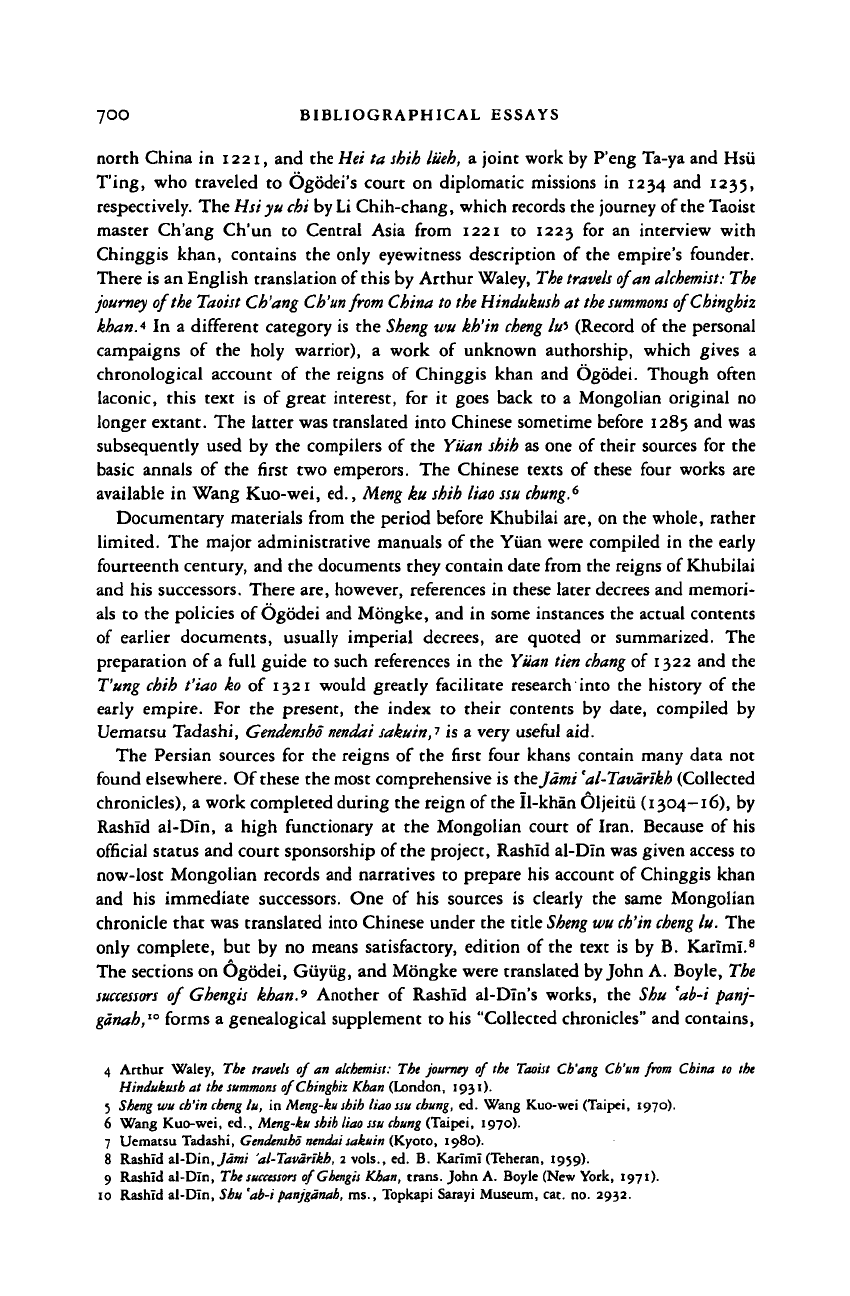
7OO BIBLIOGRAPHICAL ESSAYS
north China in 1221, and the
Hei
ta
shih
liieh,
a joint work by P'eng Ta-ya and Hsu
Ting, who traveled to Ogodei's court on diplomatic missions in 1234 and 1235,
respectively. The Hsiyu
chi
by
Li
Chih-chang, which records the journey of
the
Taoist
master Ch'ang Ch'un to Central Asia from 1221 to 1223 for an interview with
Chinggis khan, contains the only eyewitness description of the empire's founder.
There is an English translation of
this
by Arthur Waley,
The travels
of
an
alchemist:
The
journey
of
the Taoist Ch'ang Ch'unfrom China to the Hindukush
at
the summons ofChinghiz
khan.
4
In a different category is the
Sheng
wu kh'in
cheng lti>
(Record of the personal
campaigns of the holy warrior), a work of unknown authorship, which gives a
chronological account of the reigns of Chinggis khan and Ogodei. Though often
laconic, this text is of great interest, for it goes back to a Mongolian original no
longer extant. The latter was translated into Chinese sometime before 1285 and was
subsequently used by the compilers of the
Yiian shih
as one of their sources for the
basic annals of the first two emperors. The Chinese texts of these four works are
available in Wang Kuo-wei, ed.,
Meng
ku
shih liao ssu
chung.
6
Documentary materials from the period before Khubilai are, on the whole, rather
limited. The major administrative manuals of the Yiian were compiled in the early
fourteenth century, and the documents they contain date from the reigns of Khubilai
and his successors. There are, however, references in these later decrees and memori-
als to the policies of Ogodei and Mongke, and in some instances the actual contents
of earlier documents, usually imperial decrees, are quoted or summarized. The
preparation of a full guide to such references in the
Yiian tien chang
of 1322 and the
Tung
chih
t'iao
ko of 1321 would greatly facilitate research into the history of the
early empire. For the present, the index to their contents by date, compiled by
Uematsu Tadashi,
Gendensho nendai
sakuin,
1
is a very useful aid.
The Persian sources for the reigns of the first four khans contain many data not
found elsewhere. Of
these
the most comprehensive is the
J'ami
'al-Tavarikh
(Collected
chronicles), a work completed during the reign of the Il-khan Oljeitii (1304-16), by
Rashld al-DIn, a high functionary at the Mongolian court of Iran. Because of his
official status and court sponsorship of the project, Rashld al-DIn was given access to
now-lost Mongolian records and narratives to prepare his account of Chinggis khan
and his immediate successors. One of his sources is clearly the same Mongolian
chronicle that was translated into Chinese under the title
Sheng wu ch'in cheng
lu.
The
only complete, but by no means satisfactory, edition of the text is by B. Karlml.
8
The sections on Ogodei, Giiyiig, and Mongke were translated
by
John A. Boyle, The
successors
of
Ghengis khan."> Another
of
Rashld al-Dln's
works,
the Shu 'ab-i
panj-
ganai>,'°
forms a genealogical supplement to his "Collected chronicles" and contains,
4 Arthur Waley, The travels of an alchemist: The journey of the Taoist Ch'ang Ch'un from China to the
Hindukush at the
summons
ofCbinghiz Khan (London, 1931).
5 Sheng wu ch'in
cbeng
lu, in Meng-ku
shih
liao
ssu
chung,
ed. Wang Kuo-wei (Taipei, 1970).
6 Wang Kuo-wei, ed., Meng-ku shih liao ssu
chung
(Taipei, 1970).
7 Uematsu Tadashi,
Gendensho nendai
sakuin (Kyoto, 1980).
8 Rashld al-Din, Jami 'al-Tavartkh, 2 vols., ed. B. Karlml (Teheran, 1959).
9 Rashld al-Drn, The
successors
of
Ghengis
Khan, trans. John A. Boyle (New York, 1971).
10 Rashld al-Din, Shu 'ab-ipanjgdnah, ms., Topkapi Sarayi Museum, cat. no. 2932.
Cambridge Histories Online © Cambridge University Press, 2008

BIBLIOGRAPHICAL ESSAYS 7OI
as well, many data on the titles and ethnic background of officials who served at the
courts of Chinggis khan, Ogodei, and Mongke. Unfortunately, there is as yet no
printed edition of this unique and important manuscript.
In preparing his history of the reigns of
Ogodei,
Guyiig, and Mongke, Rashld al-
Dln frequently used Juvayni's
Tarktkh-i
jahdn-gushd"
(History of the world con-
queror), finished in around 1260, of which there is an excellent edition by Muham-
mad Qazvlnl and a fine translation
by
John A. Boyle. Juvaynl, a mid-level official in
the Mongolian administration in Iran, was intimately familiar with the politics and
personalities of the 1240s and 1250s and, although generally pro-Mongolian and
always pro-Toluid, his narrative is crucial to this period, especially in regard to
matters of taxation and administration. Another Persian historian who chronicles the
rise of the Mongolian empire from its inception to 1259
is
Juzjani, whose work, the
Tabaqdt-i-nasjrP*
(The tables of Nasjri), is a useful corrective
to
Juvayni's rather pro-
Mongolian attitude. Juzjani, as an outsider hostile to the invaders, presents their
conquest of the Islamic lands in a much different light. There is a serviceable but
rather eccentric translation of Juzjani by H. G. Raverty,
"Xabaqat-i-nasjri.^
In look-
ing at the period of the early empire, these three Persian historians should always be
consulted jointly and their data carefully compared.
European accounts of the early Mongols are not numerous, but the travelogues of
Carpini, who journeyed to Mongolia in 1245—7, and Rubruck, who made the trip in
1253-5,
are
fascinating descriptions of
the
empire at its height. Rubruck, in particu-
lar, was an attentive and critical observer of the Mongolian scene, and his account
provides much information on the political relations among the Chinggisid princes,
Mongolian policy in conquered lands, and an unsurpassed picture of Khara Khorum,
the imperial camp. These two works can be found in Christopher Dawson, ed., The
Mongol mission.
1
*
The state of the field of early Mongolian history is revealed in the fact that the first
scholarly biography of the empire's founder did not appear until 1970, when Li Tse-
fen published his fine study,
Ch'eng-chi-ssu
han
hsin-ch'uan
l
">
(A new biography of
Chinggis khan). More recently, Paul Ratchnevsky produced an equally solid biogra-
phy:
Chinggis
khan,
sein Leben und Wirken.
l6
Although popular in format, the succinct
account of Louis Hambis,
Gengis-khan,'
7
remains an excellent introduction to the
subject. On the reign of Ogodei, see N. Ts. Munkuev, Kitaiskii
istochnik 0 pervykh
mongol'skikh
khanakh'
8
(A Chinese source on the first Mongolian khans), which
concentrates on the reforms of Yeh-lii Ch'u-ts'ai. This topic is also explored by Igor
de Rachewiltz, "Yeh-lii Ch'u-ts'ai (1189-1243): Buddhist idealist and Confucian
11 'Ata Malik Juvaynl, Tarkikh-i jahan-gusha, 3 vols., ed. Mirza Muhammad Qazvlnl (London, 1912-
37);
and 'Ata Malik Juvaynl, The
history
of the world
conqueror,
2 vols. trans. John A. Boyle (Cambridge,
Mass.,
1958).
12 Minhaj al-DIn Juzjani, Jabaqat-i-nafiri, ed. W. Nassau Lees (Calcutta, 1864).
13 Minhaj al-DIn Juzjani, fabaqat-i-naslri, trans. H. G. Raverty, 2 vols. (New Delhi, 1970).
14 Christopher Dawson, ed., The Mongol
mission
(New York, 1955).
15 Li Tse-fen,
Ch'eng-chi-ssu
han
hsin-ch'uan
(Taipei, 1970).
16 Paul Ratchnevsky, Chinggis khan, sein
leben
und wirken (Wiesbaden, 1983).
17 Louis Hambis, Gengis-khan (Paris, 1973).
18 N. Ts. Munkuev, Kitaiskii
istochnik 0 pervykh mongol'skikh
khanakh (Moscow, 1965).
Cambridge Histories Online © Cambridge University Press, 2008
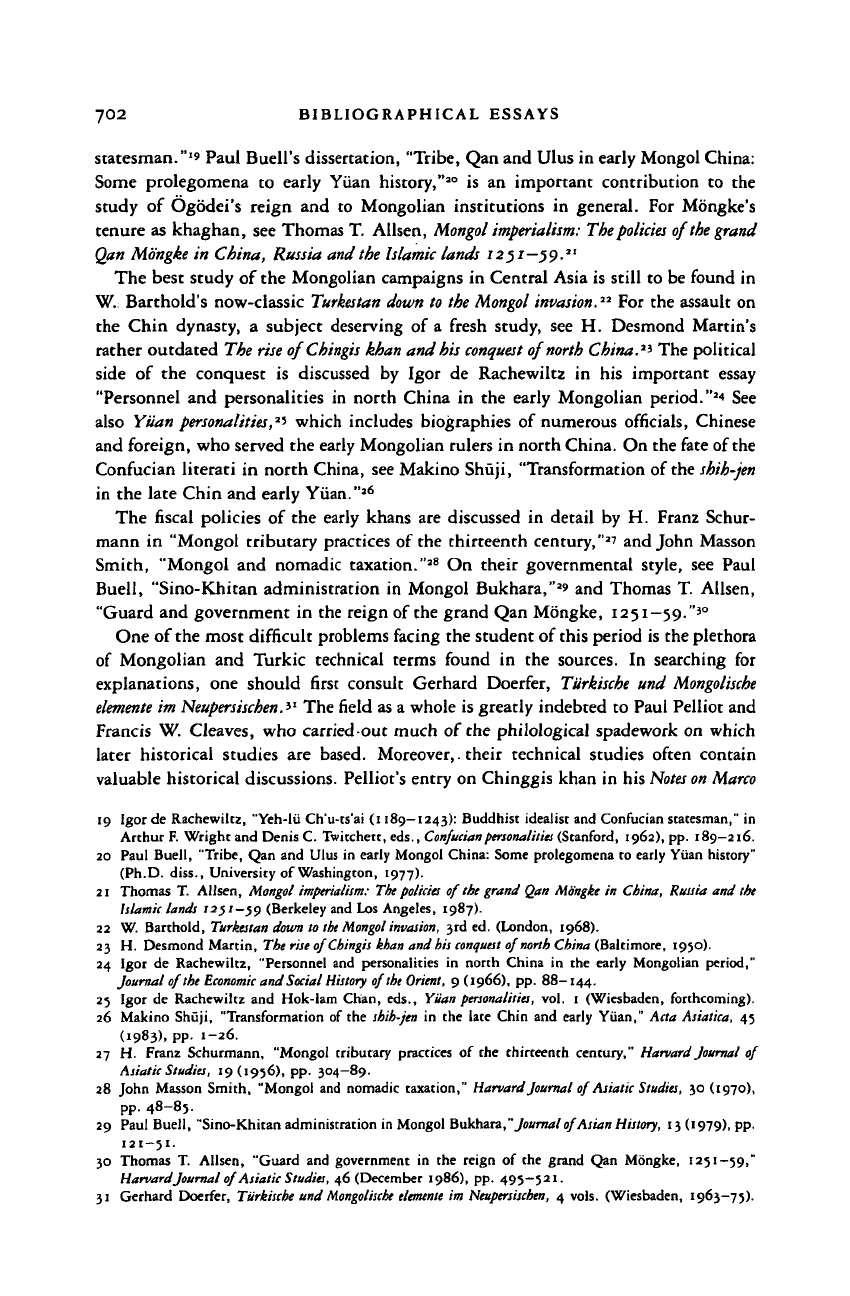
702 BIBLIOGRAPHICAL ESSAYS
statesman."
1
' Paul Buell's dissertation, "Tribe, Qan and Ulus in early Mongol China:
Some prolegomena to early Yuan history,"
20
is an important contribution to the
study of Ogodei's reign and to Mongolian institutions in general. For Mongke's
tenure as khaghan, see Thomas T. Allsen,
Mongol
imperialism:
The
policies
of
the grand
Qan Mongke
in China,
Russia and the Islamic lands
1251—59."
The best study of the Mongolian campaigns in Central Asia is still to be found in
W. Barthold's now-classic
Turkestan down to the Mongol
invasion.'
1
''
For the assault on
the Chin dynasty, a subject deserving of a fresh study, see H. Desmond Martin's
rather outdated The
rise
of
Chingis khan
and
his conquest
of
north
China.
2
*
The political
side of the conquest is discussed by Igor de Rachewiltz in his important essay
"Personnel and personalities in north China in the early Mongolian period."
2
'' See
also Yuan
personalities,
2
*
which includes biographies of numerous officials, Chinese
and foreign, who served the early Mongolian rulers in north China. On the fate of
the
Confucian literati in north China, see Makino Shuji, "Transformation of the
shih-jen
in the late Chin and early Yiian."
26
The fiscal policies of the early khans are discussed in detail by H. Franz Schur-
mann in "Mongol tributary practices of the thirteenth century,"
27
and John Masson
Smith, "Mongol and nomadic taxation."
28
On their governmental style, see Paul
Buell, "Sino-Khitan administration in Mongol Bukhara,"
29
and Thomas T. Allsen,
"Guard and government in the reign of the grand Qan Mongke, 1251-59."
3
°
One of the most difficult problems facing the student of this period is the plethora
of Mongolian and Turkic technical terms found in the sources. In searching for
explanations, one should first consult Gerhard Doerfer,
Turkische
und
Mongolische
elemente
im
Neupersischen.*
1
The field as a whole is greatly indebted to Paul Pelliot and
Francis W. Cleaves, who carriedout much of the philological spadework on which
later historical studies are based. Moreover,. their technical studies often contain
valuable historical discussions. Pelliot's entry on Chinggis khan in his
Notes on Marco
19 Igor de Rachewiltz, "Yeh-lii Ch'u-cs'ai (i 189—1243): Buddhist idealist and Confucian statesman," in
Arthur F. Wright and Denis C. Twitchett, eds.,
Confucian personalities
(Stanford, 1962), pp. 189-216.
20 Paul Buell, "Tribe, Qan and Ulus in early Mongol China: Some prolegomena to early Yiian history"
(Ph.D.
diss., University of Washington, 1977).
21 Thomas T. Allsen, Mongol imperialism:
The policies
of the grand Qan Mongke in China, Russia and the
Islamic lands 1251-59 (Berkeley and Los Angeles, 1987).
22 W. Barthold, Turkestan down to
the
Mongol
invasion,
3rd ed. (London, 1968).
23 H. Desmond Martin, The rise of Chingis khan and his
conquest
of
north
China (Baltimore, 1950).
24 Igor de Rachewiltz, "Personnel and personalities in north China in the early Mongolian period,"
Journalof the
Economic
and Social History of the Orient, 9(1966), pp. 88-144.
2;
Igor de Rachewiltz and Hok-lam Chan, eds., Yuan
personalities,
vol. 1 (Wiesbaden, forthcoming).
26 Makino Shuji, "Transformation of the shih-jen in the late Chin and early Yiian," Ada Asiatica, 4;
(1983),
pp. 1-26.
27 H. Franz Schurmann, "Mongol tributary practices of the thirteenth century," Harvard
Journal
of
Asiatic Studies, 19 (1956), pp. 304—89.
28 John Masson Smith, "Mongol and nomadic taxation," Harvard Journal of Asiatic Studies, 30 (1970),
pp.
48-85.
29 Paul Buell, "Sino-Khitan administration in Mongol Bukhara," Journal of Asian History, 13 (1979), pp.
121-51.
30 Thomas T. Allsen, "Guard and government in the reign of the grand Qan Mongke, 1251-59,"
Harvard Journal of Asiatic Studies, 46 (December 1986), pp. 495—521.
31 Gerhard Doerfer, Turkische und
Mongolische elemente
im
Neupersischen,
4 vols. (Wiesbaden, 1963-75).
Cambridge Histories Online © Cambridge University Press, 2008
